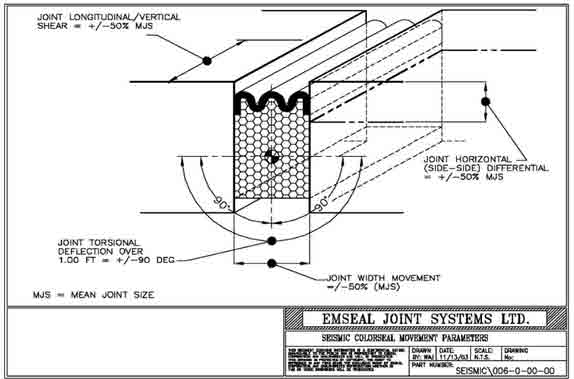What is a Movement or Expansion Joint?
An expansion joint and a movement joint are generally terms for the same thing in building and construction. As previously stated above, expansion joints are gaps to allow and accommodate the expansion of adjacent elements, primarily due to thermal movement, but also to many other possible influences. This expansion or movement joint then has the key function of allowing the building components on either side to move and expand into it - hence the names movement joint and expansion joint. An expansion joint sealing system must be designed and installed to effectively compress or expand to accommodate this movement, whilst maintaining a watertight seal.

Movement in More than One Plane and/or Direction
In summary, movement joint / expansion joint is the gap designed to separate the different constituent parts of a structure and to accommodate their anticipated movement, including the differential movement between different types of materials, in accordance with the design and exposure requirements. Therefore, in order to specify and detail an effective joint sealing approach, the joint movement capability must be calculated by the responsible engineers, usually this is made as an overall % of the joint width and then as +/- percentage of the width, or as a specific movement amount. For example, an 80mm wide joint requiring a design movement of +/-50%, would mean an ability for moving +/- 40mm, which is a potential overall joint movement of 80mm, which means that this would require a joint sealing system capable of handling at least 100% joint movement capability.
The joint movement capability must always be defined in order to correctly design, detail and position it and this may be expressed overall by the maximum movement anticipated as a +/- figure, which may both then be given as a percentage (%), or the net movement amounts, all according to the specific joint function and exposure. The requirements should always be calculated and of a predetermined nature e.g. designed to accommodate the specific thermal movement and/or the static and dynamic movement due to any loadings from other forces such as traffic for example, or indeed any other relevant exposures that are anticipated to cause movement in the joint.
Additional factors that can cause significant movement in a structure or between different elements of a structure will obviously depend on its location, exposure and function. These can include static and dynamic loading, settlement and subsidence, wind sway, vibration from machinery or traffic, direct abrasion and impact from traffic, exposure to chemicals, and in some areas even seismic events. Whilst thermal movement can create joint movement in one direction or plane, there is also the potential for simultaneous movement in other directions and/or planes, which the joint movement system must therefore also accommodate. In some instances, in addition to the sideways movement created by normal thermal expansion and contraction of a concrete slab, there is also torsional/rotary movement, which can be created by the influence of other parts of the structure, or from dynamic loading. All these possible sources of movement need to be considered if the movement joints are to be successfully and durably sealed and made watertight. For more information on how best to accommodate movement in more than one plane and typical examples and details to achieve this, including standard CAD details, please refer to the Emseal 3D Design page.
The use and types of expansion or movement joints for both buildings and civil engineering structures, are generally divided into two types:
Firstly - Smaller or lower movement joints - Generally this means a maximum joint width of 25 to 30mm, and with a maximum joint movement capability of up to 25% of the designed joint width.
Secondly - Wider and / or higher movement joints – Generally this means a joint gap that is required to be wider than 25-30mm, and / or with higher movement requirements that 25% of the joint width.
This subject of joint movement capability is somewhat complex and so this is expanded further in this website on the next pages.
